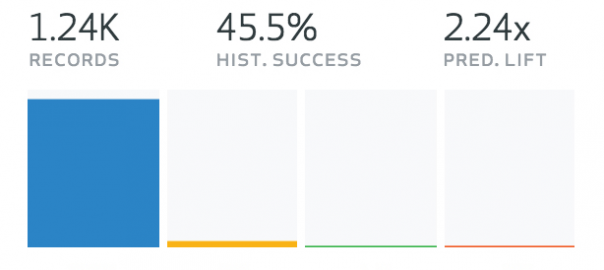Intent data is one of the latest buzzworthy trends in predictive marketing, yet many companies in the predictive space have very different viewpoints about the pros and cons of leveraging intent data. Predictive companies that offer intent data usually position it as the most important factor to reach prospects, while those that don’t claim it’s not vital.
Coming from a predictive platform that does offer intent, it’s an incredibly powerful indicator that should be leveraged, but it’s not the only thing that matters in order to find and target the prospects which are most likely to be in-market right now.
The Rundown On Intent Data
Intent data is information that indicates the interest of a business in a particular topic which can signal a company’s intent to purchase products or services.

3 Types of Data For Predictive Segmentation
Intent is derived from billions of interactions performed across the web and includes white paper downloaded on a competitor website, an article read in an industry publication, or a search for product news on a publisher website. It is aggregated by networks of B2B publishers, either at the IP level or through user registration.
“Layering intent data on your target segments is a powerful way to identify in-market prospects.” – Amogh Mundhekar, Director of Product Management, Data and Predictive at Radius
How It Fits Into The Predictive Puzzle
Intent data helps marketers reach the right companies at the right time – when they are most receptive.
It provides more color on what a prospect is doing throughout the buying cycle when they may not be engaging directly with your offerings, and sheds light on the breadcrumbs left when they aren’t engaging with your own marketing automation or CRM systems. For example, if a business watches a competitor’s webinar or registers for an industry event, even though they are not engagements with your own company, they still could be indicating intent in your offering.
Intent data allows marketers to identify and prioritize in-market accounts and reach them at the right time in the buying cycle to accelerate sales velocity and close deals before the competition.
How Marketers Should Use Intent Data
Two key intent use cases that fit perfectly into what predictive technologies offer are:
- Identifying new, hot accounts that fit your Ideal Customer Profile (ICP)
- Prioritizing accounts that are in-market to buy
The first use case involves using intent data to identify net new accounts that are in-market to buy but not yet in your database. You can also leverage the intent information and other business attributes to personalize content marketing campaigns to yield a higher response rate. The second use case involves using intent data to create a segment of in-market accounts that already exist in your database. You can also run targeted nurture campaigns and outreach campaigns to each unique segment.
Let’s look at an example of how a marketer could incorporate intent data into their segmentation efforts prior to launching a marketing campaign:
Your company sells IT security solutions to medium-sized and large financial technology companies, so you build a segment that includes these signals.
- Industry = Finance and Insurance
- Annual revenue = $ 50 to $ 100 Million
- Intent Category = Security Solutions
The segment above will include companies in the targeted industry of specified size that have shown an interest in security solutions during the past two to three weeks. You can then create a targeted campaign to sell your products and services to those prospects that fit your buying persona and have demonstrated intent.
Why Intent Data Isn’t Everything
While intent data alone is often not enough to determine whether a prospect will buy your product, it’s a strong signal to layer among others and a unique indicator of interest that is not reflected by any other attribute.
Intent data helps you target businesses that fit your Ideal Customer Profile (ICP) when they are most receptive, but you need to know who those businesses are first. Use a solution that allows you to segment and identify net-new businesses that fit your ICP and have intent in specific topics, while also including intent data within the predictive models.
If you want to learn more about intent data and how it can help marketers sharpen their segmentation & targeting efforts, download our new predictive playbook.
Business & Finance Articles on Business 2 Community
(49)
Report Post







